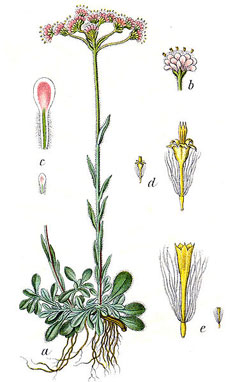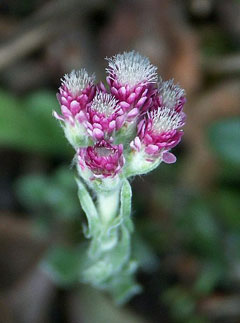 |
|
http://commons.wikimedia.org/wiki/File:Antennaria_dioica_Sturm28.jpg |
 |
| http://commons.wikimedia.org/wiki/User:Alterego(fin) |
Translate this page:
Summary
Physical Characteristics

 Antennaria dioica is an evergreen Perennial growing to 0.1 m (0ft 4in) by 0.6 m (2ft).
Antennaria dioica is an evergreen Perennial growing to 0.1 m (0ft 4in) by 0.6 m (2ft).
See above for USDA hardiness. It is hardy to UK zone 5 and is not frost tender. It is in leaf all year, in flower from June to July. The species is dioecious (individual flowers are either male or female, but only one sex is to be found on any one plant so both male and female plants must be grown if seed is required). and is pollinated by Apomictic (reproduce by seeds formed without sexual fusion). The plant is self-fertile.
Suitable for: light (sandy) soils, prefers well-drained soil and can grow in nutritionally poor soil. Suitable pH: mildly acid, neutral and basic (mildly alkaline) soils. It cannot grow in the shade. It prefers dry or moist soil and can tolerate drought.
UK Hardiness Map
US Hardiness Map
Synonyms
Gnaphalium dioicum. Antennaria hibernica. Antennaria insularis. Cyttarium dioicum.
Plant Habitats
Ground Cover;
Edible Uses
References More on Edible Uses
Medicinal Uses
Plants For A Future can not take any responsibility for any adverse effects from the use of plants. Always seek advice from a professional before using a plant medicinally.
Antitussive Astringent Cholagogue Diuretic Emollient
Catsfoot has been little used in herbal medicine though it was once used in mixtures for the treatment of bronchitis and bilious conditions[268]. The whole plant is antitussive, astringent, cholagogue, discutient, diuretic and emollient[4, 7, 9, 21]. The plant is very rich in mucilage which makes it very valuable in the treatment of chest complaints[7]. It is also used in the treatment of liver and gall bladder complaints, hepatitis and diarrhoea[238]. Externally it is used as a gargle for treating tonsillitis and as a douche for vaginitis[238]. The herb is gathered in May before it comes into flower and can be dried for later use[7].
References More on Medicinal Uses
The Bookshop: Edible Plant Books
Our Latest books on Perennial Plants For Food Forests and Permaculture Gardens in paperback or digital formats.

Edible Tropical Plants
Food Forest Plants for Hotter Conditions: 250+ Plants For Tropical Food Forests & Permaculture Gardens.
More

Edible Temperate Plants
Plants for Your Food Forest: 500 Plants for Temperate Food Forests & Permaculture Gardens.
More

More Books
PFAF have eight books available in paperback and digital formats. Browse the shop for more information.
Shop Now
Other Uses
A good ground cover plant for sunny positions. Rather slow to spread, however, and it requires weeding for at least the first year[197]. Plants form a carpet and root as they spread[208].
Special Uses
Food Forest Ground cover
References More on Other Uses
Cultivation details
Prefers a light well-drained soil in full sun, succeeding in poor soils[1, 133, 200]. Established plants are drought tolerant[190]. This species is very susceptible to slug damage, the young growth in spring is particularly at risk[K]. Tolerates light treading[200]. The flowers are sometimes cut and used as 'everlasting flowers' since they dry well and keep their colour[7]. Plants are usually dioecious, male and female plants must be grown if seed is required. Some male plants have a few hermaphrodite flowers, though these are usually sterile. Apomictic flowers are also produced[17], these produce seed without sexual fertilization, each seedling being a clone of the parent plant. The plant is heat tolerant in zones 9 through 4. (Plant Hardiness Zones show how well plants withstand cold winter temperatures.
Plant Heat Zones show when plants would start suffering from the heat.
The Plant Heat Zone map is based on the number of "heat days" experienced in a given area where the temperature climbs to over 86 degrees F (30°C).
At this temperature, many plants begin to suffer physiological damage. Heat Zones range from 1 (no heat days) to 12 (210 or more heat days).
For example Heat Zone. 11-1 indicates that the plant is heat tolerant in zones 11 through 1.) For polyculture design as well as the above-ground architecture (form - tree, shrub etc. and size shown above) information on the habit and root pattern is also useful and given here if available. An evergreen. The plant growth habit is a clumper with limited spread [1-2]. The root pattern is stoloniferous rooting from creeping stems above the ground [1-2].
References Carbon Farming Information and Carbon Sequestration Information
Temperature Converter
Type a value in the Celsius field to convert the value to Fahrenheit:
Fahrenheit:
The PFAF Bookshop
Plants For A Future have a number of books available in paperback and digital form. Book titles include Edible Plants, Edible Perennials, Edible Trees,Edible Shrubs, Woodland Gardening, and Temperate Food Forest Plants. Our new book is Food Forest Plants For Hotter Conditions (Tropical and Sub-Tropical).
Shop Now
Plant Propagation
Seed - sow spring in cold frame and only just cover the seed. Do not allow the soil to dry out. The seed germinates in 1 -2 months at 15°c. Prick out the seedlings into individual pots when they are large enough to handle and plant them out in late spring of the following year[K]. Division in spring or autumn. Fairly easy, the divisions can be planted out direct into their permanent positions if required.
Other Names
If available other names are mentioned here
Native Range
TEMPERATE ASIA: Armenia, Azerbaijan, China, Ciscaucasia, Eastern Siberia, Far East, Gansu Sheng, Georgia, Heilongjiang Sheng, Hokkaidô, Japan, Kazakhstan, Korea, Kurile Islands, Mongolia, Russian Federation, Russian Federation-Eastern Siberia, Russian Federation-Far East, Russian Federation-Western Siberia, South, Western Siberia, Xinjiang Uygur Zizhiqu,Russian Federation-Ciscaucasia. NORTHERN AMERICA: United States, Alaska (Aleutian Islands), EUROPE: Denmark, Finland, United Kingdom (U.K.), Ireland, Norway, Sweden, Austria, Belgium, Switzerland, Czech Republic, Germany, Hungary, Netherlands, Poland, Slovakia, Russian Federation-European part, European part, Belarus, Estonia, Lithuania, Latvia, Moldova, Ukraine (incl. Krym), Albania, Bulgaria, Bosnia and Herzegovina, Greece, Croatia, Italy, North Macedonia, Montenegro, Romania, Serbia, Slovenia, Spain, France,
Weed Potential
Right plant wrong place. We are currently updating this section.
Please note that a plant may be invasive in one area but may not in your area so it's worth checking.
Conservation Status
IUCN Red List of Threatened Plants Status :

Growth: S = slow M = medium F = fast. Soil: L = light (sandy) M = medium H = heavy (clay). pH: A = acid N = neutral B = basic (alkaline). Shade: F = full shade S = semi-shade N = no shade. Moisture: D = dry M = Moist We = wet Wa = water.
Now available:
Food Forest Plants for Mediterranean Conditions
350+ Perennial Plants For Mediterranean and Drier Food Forests and Permaculture Gardens.
[Paperback and eBook]
This is the third in Plants For A Future's series of plant guides for food forests tailored to
specific climate zones. Following volumes on temperate and tropical ecosystems, this book focuses
on species suited to Mediterranean conditions—regions with hot, dry summers and cool, wet winters,
often facing the added challenge of climate change.
Read More
Expert comment
Author
(L.)Gaertn.
Botanical References
17200
Links / References
For a list of references used on this page please go here
Readers comment
© 2010, Plants For A Future. Plants For A Future is a charitable company limited by guarantee, registered in England and Wales. Charity No. 1057719, Company No. 3204567.